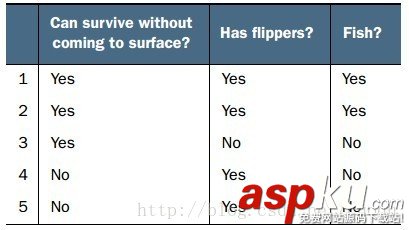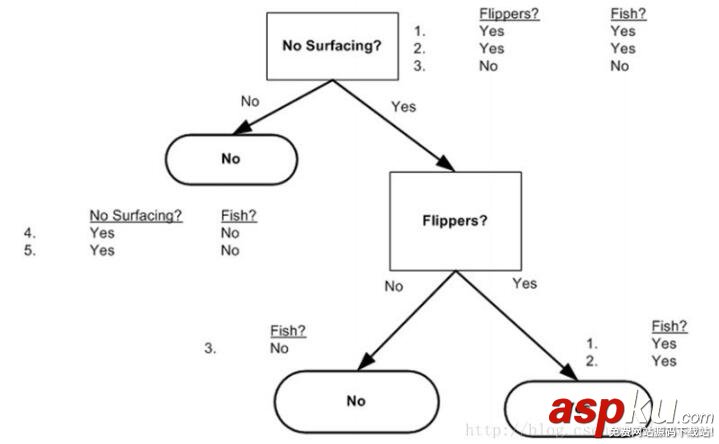決策樹也是有監(jiān)督機(jī)器學(xué)習(xí)方法。 電影《無恥混蛋》里有一幕游戲,在德軍小酒館里有幾個(gè)人在玩20問題游戲,游戲規(guī)則是一個(gè)設(shè)迷者在紙牌中抽出一個(gè)目標(biāo)(可以是人,也可以是物),而猜謎者可以提問題,設(shè)迷者只能回答是或者不是,在幾個(gè)問題(最多二十個(gè)問題)之后,猜謎者通過逐步縮小范圍就準(zhǔn)確的找到了答案。這就類似于決策樹的工作原理。(圖一)是一個(gè)判斷郵件類別的工作方式,可以看出判別方法很簡單,基本都是閾值判斷,關(guān)鍵是如何構(gòu)建決策樹,也就是如何訓(xùn)練一個(gè)決策樹。

(圖一)
構(gòu)建決策樹的偽代碼如下:
Check if every item in the dataset is in the same class: If so return the class label Else find the best feature to split the data split the dataset create a branch node for each split call create Branch and add the result to the branch node return branch node
原則只有一個(gè),盡量使得每個(gè)節(jié)點(diǎn)的樣本標(biāo)簽盡可能少,注意上面?zhèn)未a中一句說:find the best feature to split the data,那么如何find thebest feature?一般有個(gè)準(zhǔn)則就是盡量使得分支之后節(jié)點(diǎn)的類別純一些,也就是分的準(zhǔn)確一些。如(圖二)中所示,從海洋中撈取的5個(gè)動(dòng)物,我們要判斷他們是否是魚,先用哪個(gè)特征?

(圖二)
為了提高識別精度,我們是先用“離開陸地能否存活”還是“是否有蹼”來判斷?我們必須要有一個(gè)衡量準(zhǔn)則,常用的有信息論、基尼純度等,這里使用前者。我們的目標(biāo)就是選擇使得分割后數(shù)據(jù)集的標(biāo)簽信息增益最大的那個(gè)特征,信息增益就是原始數(shù)據(jù)集標(biāo)簽基熵減去分割后的數(shù)據(jù)集標(biāo)簽熵,換句話說,信息增益大就是熵變小,使得數(shù)據(jù)集更有序。熵的計(jì)算如(公式一)所示:

有了指導(dǎo)原則,那就進(jìn)入代碼實(shí)戰(zhàn)階段,先來看看熵的計(jì)算代碼:
def calcShannonEnt(dataSet): numEntries = len(dataSet) labelCounts = {} for featVec in dataSet: #the the number of unique elements and their occurance currentLabel = featVec[-1] if currentLabel not in labelCounts.keys(): labelCounts[currentLabel] = 0 labelCounts[currentLabel] += 1 #收集所有類別的數(shù)目,創(chuàng)建字典 shannonEnt = 0.0 for key in labelCounts: prob = float(labelCounts[key])/numEntries shannonEnt -= prob * log(prob,2) #log base 2 計(jì)算熵 return shannonEnt 有了熵的計(jì)算代碼,接下來看依照信息增益變大的原則選擇特征的代碼:
def splitDataSet(dataSet, axis, value): retDataSet = [] for featVec in dataSet: if featVec[axis] == value: reducedFeatVec = featVec[:axis] #chop out axis used for splitting reducedFeatVec.extend(featVec[axis+1:]) retDataSet.append(reducedFeatVec) return retDataSet def chooseBestFeatureToSplit(dataSet): numFeatures = len(dataSet[0]) - 1 #the last column is used for the labels baseEntropy = calcShannonEnt(dataSet) bestInfoGain = 0.0; bestFeature = -1 for i in range(numFeatures): #iterate over all the features featList = [example[i] for example in dataSet]#create a list of all the examples of this feature uniqueVals = set(featList) #get a set of unique values newEntropy = 0.0 for value in uniqueVals: subDataSet = splitDataSet(dataSet, i, value) prob = len(subDataSet)/float(len(dataSet)) newEntropy += prob * calcShannonEnt(subDataSet) infoGain = baseEntropy - newEntropy #calculate the info gain; ie reduction in entropy if (infoGain > bestInfoGain): #compare this to the best gain so far #選擇信息增益最大的代碼在此 bestInfoGain = infoGain #if better than current best, set to best bestFeature = i return bestFeature #returns an integer
從最后一個(gè)if可以看出,選擇使得信息增益最大的特征作為分割特征,現(xiàn)在有了特征分割準(zhǔn)則,繼續(xù)進(jìn)入一下個(gè)環(huán)節(jié),如何構(gòu)建決策樹,其實(shí)就是依照最上面的偽代碼寫下去,采用遞歸的思想依次分割下去,直到執(zhí)行完成就構(gòu)建了決策樹。代碼如下:
def majorityCnt(classList): classCount={} for vote in classList: if vote not in classCount.keys(): classCount[vote] = 0 classCount[vote] += 1 sortedClassCount = sorted(classCount.iteritems(), key=operator.itemgetter(1), reverse=True) return sortedClassCount[0][0] def createTree(dataSet,labels): classList = [example[-1] for example in dataSet] if classList.count(classList[0]) == len(classList): return classList[0]#stop splitting when all of the classes are equal if len(dataSet[0]) == 1: #stop splitting when there are no more features in dataSet return majorityCnt(classList) bestFeat = chooseBestFeatureToSplit(dataSet) bestFeatLabel = labels[bestFeat] myTree = {bestFeatLabel:{}} del(labels[bestFeat]) featValues = [example[bestFeat] for example in dataSet] uniqueVals = set(featValues) for value in uniqueVals: subLabels = labels[:] #copy all of labels, so trees don't mess up existing labels myTree[bestFeatLabel][value] = createTree(splitDataSet(dataSet, bestFeat, value),subLabels) return myTree 用圖二的樣本構(gòu)建的決策樹如(圖三)所示:

(圖三)
有了決策樹,就可以用它做分類咯,分類代碼如下:
def classify(inputTree,featLabels,testVec): firstStr = inputTree.keys()[0] secondDict = inputTree[firstStr] featIndex = featLabels.index(firstStr) key = testVec[featIndex] valueOfFeat = secondDict[key] if isinstance(valueOfFeat, dict): classLabel = classify(valueOfFeat, featLabels, testVec) else: classLabel = valueOfFeat return classLabel
最后給出序列化決策樹(把決策樹模型保存在硬盤上)的代碼:
def storeTree(inputTree,filename): import pickle fw = open(filename,'w') pickle.dump(inputTree,fw) fw.close() def grabTree(filename): import pickle fr = open(filename) return pickle.load(fr)
優(yōu)點(diǎn):檢測速度快
缺點(diǎn):容易過擬合,可以采用修剪的方式來盡量避免
參考文獻(xiàn):machine learning in action
以上就是本文的全部內(nèi)容,希望對大家的學(xué)習(xí)有所幫助,也希望大家多多支持VEVB武林網(wǎng)。
新聞熱點(diǎn)
疑難解答
圖片精選